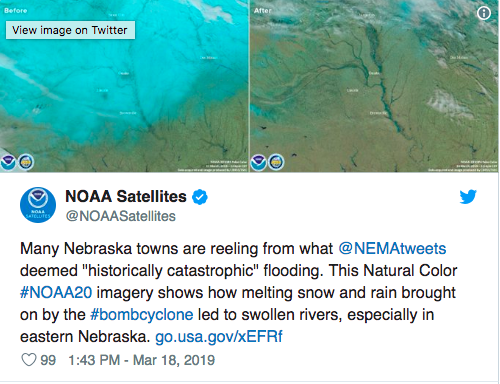
The floods pummeling the Midwest this week could be the last straw for many small farmers and ranchers who were already struggling to make ends meet and then had to deal with the impacts of the President’s trade wars. The New York Times explained that bankruptcy filings by farmers were up 19 percent last year across the Midwest to their highest level in a decade, and now for many of those farmers, their livestock and land have been washed away. Rail lines and roads that carry their farm products to market are also gone — taken out by the flood waters. In Nebraska, one county, Holt, is 70 percent flooded. Farmers lost many cattle and calves as ice and debris swept them away — while others can’t be fed because either the animals or the farmers are stranded by the flood waters — and because farmers are hurting more have had to sell their livestock, causing a glut on the market.
Meanwhile, Offutt Air Force Base in Nebraska is still flooded and the base commander is hoping the waters will recede by the end of the week. The full extent of the damage there has not yet been determined, but fifty buildings have sustained damage. The base is closed to all but mission-essential personnel and the people who are living there. Offutt is a key installation for U.S. defenses — it is the home of U.S. Strategic Command, which oversees the Pentagon’s nuclear deterrence and global strike capabilities. A new $1.3 billion dollar headquarters for Strategic Command just opened at the air base in January. Offut was not listed as at risk of flooding in the Pentagon’s January report on installations at risk due to climate change, according to The Washington Post.
The National Weather Service says that the severity of the flooding is a result of late snow in the upper midwest, high plains, and mountain west, that was followed by a rapid thaw, and then finally the bombogenesis storm that brought more rain, snow, and wind that fell on the frozen and already saturated ground with nowhere soak in. As a result, now there are two “waves of water” working their way south — one along the Missouri River and one along the Upper Mississippi River. The “Black Friday” climate report accurately predicted that storm events like this one in this region would be increasingly likely due to climate change, stating “effective water management is critical to the region’s people, crops and livestock, ecosystems, and energy industry. Even small changes in annual precipitation can have large effects downstream; when coupled with the variability from extreme events, these changes make managing these resources a challenge.”
Why This Matters: Family farms were saved by the New Deal in the 1930s and the Green New Deal has the potential to take on this challenge for the agriculture sector. This week’s floods have proven (again) that DoD is not ready for the climate impacts to its installations that are likely (or already happening) and as a result, our national security is weakened, despite massive defense spending. For example, Strategic Command’s new headquarters is one of the most expensive building projects ever undertaken by the Defense Department and yet they were trying to sandbag around the installation to keep the flood waters out — to no avail. But the Trump Administration is doubling down on their climate denial. They have a “commission” of experts working out of the National Security Council in the White House trying to “water down” the DoD climate report. At the same time, the Administration announced yesterday that it is moving $12.9 billion out of military construction funds in order to fund the border wall. Perhaps the construction projects were not necessary — but there are plenty of climate-related DoD projects that truly are essential. By DoD’s own admission, more than two-thirds of U.S. military installations considered to be “operationally critical” faced risks from the warming climate.

March 20, 2019 » climate change, DOD, farmers, floods, Green New Deal, livestock, military installations, Mississippi River, Missouri River, Nebraska, Offutt Air Force Base

